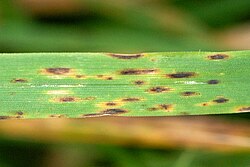Cochliobolus sativus
| Cochliobolus sativus | |
|---|---|
 |
|
| Symptoms on a wheat leaf | |
| Scientific classification | |
| Kingdom: | Fungi |
| Phylum: | Ascomycota |
| Subphylum: | Pezizomycotina |
| Class: | Dothideomycetes |
| Order: | Pleosporales |
| Family: | Pleosporaceae |
| Genus: | Cochliobolus |
| Species: | C. sativus |
| Binomial name | |
|
Cochliobolus sativus (S. Ito & Kurib.) Drechsler ex Dastur (1942) |
|
| Synonyms | |
|
Bipolaris californica (Mackie & G.E. Paxton) Gornostaĭ (1978) |
|
Bipolaris californica (Mackie & G.E. Paxton) Gornostaĭ (1978)
Bipolaris sorokiniana (Sacc.) Shoemaker (1959)
Drechslera sorokiniana (Sacc.) Subram. & B.L. Jain (1966)
Helminthosporium acrothecioides Lindf. (1918)
Helminthosporium californicum Mackie & G.E. Paxton (1923)
Helminthosporium sativum Pammel, C.M. King & Bakke (1910)
Helminthosporium sorokinianum Sacc. (1890)
Ophiobolus sativus S. Ito & Kurib. (1929)
The fungus Cochliobolus sativus is the teleomorph (sexual stage) of Bipolaris sorokiniana (anamorph) which is the causal agent of a wide variety of cereal diseases. The pathogen can infect and cause disease on the root (where it is known as common root rot), leaf and stem, and head tissue. C.sativus is extremely rare in nature and thus it is the asexual or anamorphic stage which causes infections. The two most common diseases caused by B.sorokiniana are spot blotch and common root rot, mainly on wheat and barley crops.
The mycelium of B.sorokiniana is usually deep olive-brown. New cultures produce abundant simple conidiophores, which may be single or clustered and measure 6-10 x 110-220 μm with septations. Conidia develop laterally from pores beneath each conidiophore setpum. Conidia are olive-brown and ovate to oblong, with rounded ends and a prominent basal scar. They measure 15-28 x 40-120 μm and are 3- to 10- septate. Some may be slightly curved. Their walls are smooth and noticeably thickened at the septa.
The sexual state (C.sativus), when formed in culture, is in the form of black, globose pseudothecia 300-400 μm in diameter, with erect beaks 50-200 μm long. Asci are clavate and measure 20-35 x 150-250 μm. Ascospores are hyaline, uniformly filamentous, and spirally flexed within asci. They measure 5-10 x 200-250 μm and are 4- to 10-septate.
Agropyron cristatum1, Allium sp. 1, Alopecurus pratensis1, Aneurolepidium chinense1, Avena sativa1
...
Wikipedia
